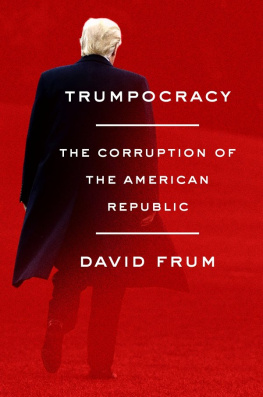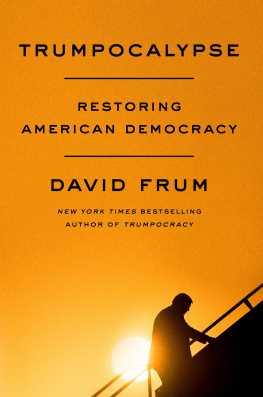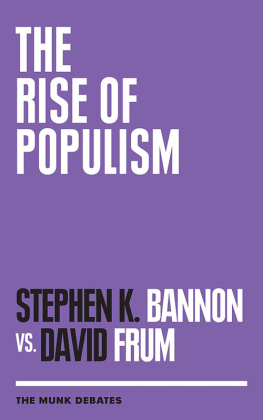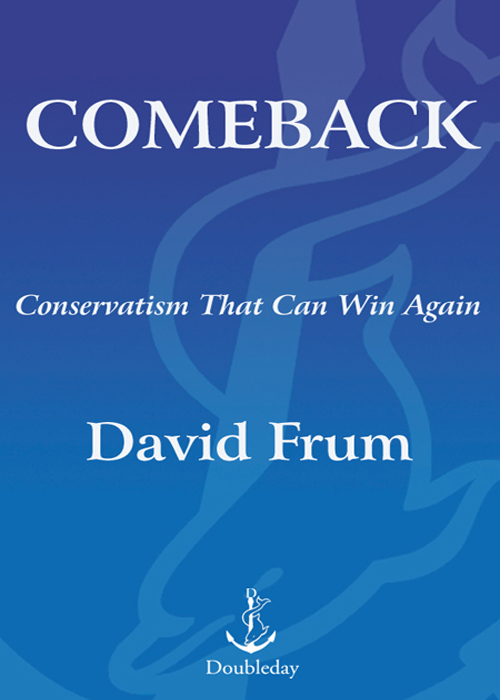
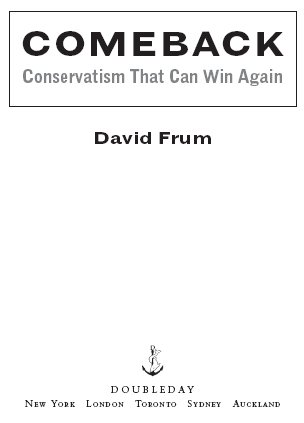
CONTENTS
One: George W. Bush:
What Went Wrong?
Four: Goal One:
A Better Deal for the Middle Class
Five: Goal Two:
Keep China Number Two
Six: Goal Three:
New Life for the Pro-Life
Seven: Goal Four:
Green Conservatism
Eight: Goal Five:
Win the War on Terror
Nine: Goal Six:
Rediscover Conservative Ideals
To Peter Worthington,
Who Taught Courage to Three Generations
ONE
GEORGE W. BUSH:
What Went Wrong?
I n January 2003, I published one of the very first memoirs of the Bush administration, The Right Man: The Surprise Presidency of George W. Bush.
Over the years since, the Bush administration has been hammered by difficulties and disappointments. And I have often found myself fighting against the administration I once served: against the prescription drug plan, against the Harriet Miers nomination to the Supreme Court, against amnesty for illegal aliens. During those fights, it was usually only a matter of time before I was sarcastically asked, Sois George Bush still the right man?
On the credit side: George Bush led the U.S. economy through its longest-ever expansion. He correctly identified the tyranny and misgovernment of the Middle East as the crucial cause of Islamic terrorism. He enhanced the security of the whole world by removing Saddam Hussein from control of the second most important Arab oil state. Bush showed courage on stem cells, and (Miers aside) he nominated excellent conservative judges.
On the debit side: So many mistakes! And such stubborn refusal to correct them when there was still time! So many lives needlessly sacrificed, so much money wasted, so many friends alienated, so many enemies strengthened. No American president since Harry Truman has been so unpopular so long as George W. Bush. Bushs Republicans suffered one fearful defeat in 2006 and seem poised to suffer another in 2008. A generation of young Americans has been lost to our party.
What went wrong? Many will want to load the blame for all the disappointments of the Bush presidency on the president himself. He surely deserves much of the blame. Why did he appoint such consistently mediocre people to such important jobs? Where was he in the summer of 2003, as Iraq began to go wrong? Why did he keep saying one thing and then doing the opposite on issues from Middle Eastern democracy to the North Korean nuclear bomb? Why did he make so little effort to persuade the American public? Why defy the nation and the party and adopt immigration amnesty as a supreme priority? Why did he spend so lavishlywhile improving government so little?
I warned in 2003 of George Bushs stubbornness, his hastiness, and his inattention to detail. I believed then that his sheer determination to prevail in the war on terror would elevate him above such limitations. In that belief I was mistaken. Bushs eagerness for bold action was again and again frustrated by his disinclination to acknowledge unwelcome realities. He persuaded himself that the regimes most responsible for the growth of radicalismSaudi Arabia and Pakistancould nonetheless be relied upon as allies. He publicly declared that he would prevent Iran from acquiring nuclear weapons, without any strategy to make his word good. In his eagerness to avoid condemning all Muslims as terrorists, he deceived himself about the prevalence of extremism among Muslims worldwide. George W. Bush had the right instincts, but the wrong methods. He identified the right path, but stumbled when he tried to walk it.
Yet we conservatives and Republicans must face some truths about ourselves as well. In important ways, Bush saw more clearly than we. He recognized that the conservatism of the 1980s and 1990s had exhausted itself.
After the triumph of 1994, we lost the battle over the government shutdown in 1995. Running as a Reagan conservative, Bob Dole lost the presidential election of 1996. In the court of public opinion, we lost the impeachment fight. We lost the congressional elections of 1998the first time since 1822 that a nonpresidential party had failed to gain seats in the sixth year of a presidential term.
Bush had won the biggest Republican victory of that otherwise frustrating year. He was reelected governor of Texas in 1998 by the highest margin of any reelected governor in the country, almost 70 percent of the vote, due in large measure to his breakthrough success among women and minorities.
Republicans turned to George Bush because he seemed to offer an escape from a dead end into which we had steered ourselves. Had we nominated a Reagan-style conservative in 2000, we would certainly have lost again. Bill Clinton left office tainted by scandalbut protected by a 65 percent end-of-presidency approval rating, higher than Reagans, higher than Eisenhowers.
The 2000 election could easily have proven itself a 1988 in reverse. Al Gore could have won a third Clinton term just as George H. W. Bush won a third Reagan term. If the Republicans had nominated a principled small-government conservative in 2000, Gore surely would have won that third term. Instead, it was George W. Bush who cunningly presented himself as Clintons true heir. Like Clinton, Bush vowed to protect Medicare and Medicaid from all proposals to retrench or reform them. Like Clinton, Bush claimed a record as an education governor. Like Clinton, Bush promised a small tax cut only after he had met all his spending priorities. Like Clinton, Bush deftly maneuvered his opponents away from the political center. By Election Day 2000, it was Gore who was running as the candidate of change (the people versus the powerful); it was George W. Bush who was promising to continue the Clinton prosperity without the Clinton scandals.
Bush often told aides that his top political priority was to change the party, that is, to move it away from the Reagan-style conservatism of the 1980s toward a new, softer centrism. His party, however, believed that he was leading the nation back toward Reagan-style conservatism. This obvious contradiction placed Bush in a terrible bind from the very start. His failure to win a popular-vote mandate in November 2000 tightened the bind. Bush sought to escape his dilemma through a careful balancing of policies, sometimes leaning left, sometimes rightagain mimicking the Clinton model.
Triangulation worked for Clinton because he ceased after 1994 to try to do anything big. Clinton ran his presidency in survival mode, avoiding risks, minimizing his political vulnerabilities. Bush, however, hated small ball. He took big risks, but he took those risks for the sake of policies radically at odds with one another.
In the war on terror, Bush triangulated between promoting democracy to defeat Islamism and supporting authoritarian allies against Islamism. He sought to defeat radical Islam with the support of radical Islams principal backers: the Saudi monarchy and the Pakistani military. He ended up running two contradictory foreign policies, and unsurprisingly, both ended badly.
At home, Bush triangulated between radical free-market reforms in Social Security and Medicare on the one hand and a huge expansion in governments grip upon prescription drugs, farming, and energy on the other. He cut taxes and increased spending. He sought to protect the nation from foreign terrorists while propping open the doors to huge new waves of foreign immigration. Unsurprisingly, these contradictory policies ended badly too.
Next page

